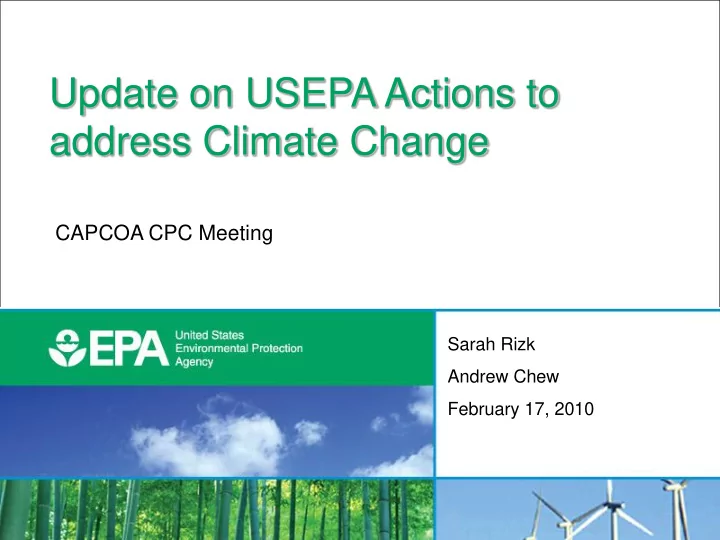

Update on USEPA Actions to address Climate Change CAPCOA CPC Meeting Sarah Rizk Andrew Chew February 17, 2010 1
USEPA Actions to Address Climate Change • Endangerment and Cause and Contribute Findings – Finalized Dec. 7, ‘09 - In response to Massachusetts vs. EPA, 2007 • Renewable Fuels Standard 2 - Finalized February 3 ‘09 - Standards for 2010 fuel production • Light-Duty Vehicle Greenhouse Gas Emission Standards and Corporate Average Fuel Economy Standards – Proposed September ‘09 - Joint rulemaking by EPA and DOT • GHG Reporting Rule - Finalized September ‘09 - Reporting to start in 2011 for calendar year 2010 • PSD/Title V, GHG Tailoring Rule – Proposed September ‘09 - Comment period ends 12/28 • Geologic Sequestration of CO2 Rule – Proposed July 08 - Final Rule Late 2010/Early 2011 • Waste Energy Recovery Registry – Proposed July 09 - Final Rule in expected in May 2
Endangerment and Cause and Contribute Findings • Finalized December 7, 2009 • In response to Massachusetts vs. EPA Supreme Court Case • Finding that: – 6 GHGs threaten the public health and welfare, & – Combined emissions from 4 GHGs (CO2, CH4, N2O, and HFCs) from new motor vehicles and motor vehicle engines contribute to atmospheric concentrations For more information, visit: www.epa.gov/climatechange/endangerment.html 3
Renewable Fuel Standard (RFS 2) Lifecycle GHG Thresholds in Energy 40 Independence & Security Advanced Biofuel: Unspecified Advanced Biofuel: Biomass-Based Diesel 35 Act (EISA) Advanced Biofuel: Cellulosic Biofuel Conventional Biofuel (reductions using 2005 30 baseline) 25 Billion Gallons Renewable fuel 20% 20 15 Advanced 50% biofuel 10 RFS1 Biomass-based 50% 5 diesel 0 2009 2010 2011 2012 2013 2014 2015 2016 2017 2018 2019 2020 2021 2022 Cellulosic 60% Year biofuel 4
Proposed Greenhouse Gas Emissions Standards for Light-Duty Vehicles • Collaborative effort: EPA, DOT, United Auto Workers, Auto Manufacturers, State of CA – Joint rulemaking between DOT and EPA • Fuel Economy and Vehicle Emission Standards to start in model year 2012, ramp up by 2016 to: CAFE Standards DOT Proposed EPA Proposed Approximate EPA 2012-2016 Goals 2016 Goals MPG Equivalent Passenger car 27.5 MPG 38 MPG 224 g/mile Light-duty Truck 23.1 MPG 28.3 MPG 302 g/mile Combined Car & 250 g/mile 35.5 MPG Truck • Encompasses 60% US transportation emissions, which are 30% total US emissions – requires 5% reduction per year • Technology shifts anticipated: downsized engines with turbochargers, advanced transmission, idle reduction, A/C improvements www.epa.gov/otaq/climate/regulations.htm 5
Mandatory Greenhouse Gas Reporting — Key Elements of the Rule • Threshold: 25,000 metric tons of GHG emissions/ year • Reporting: facility-based, direct to EPA • Methodology: direct measurement from power plants, facility-specific calculation methods for other source categories • Frequency: annual – Data collection begins Jan. 1 2010; first report due March 31, 2011 • Verification: EPA verifies reports • Relationship to state programs: does not preempt states from regulating or requiring reporting of GHGs 6
Proposed GHG Tailoring Rule and Permits 7
Why We Need the Tailoring Rule • To tailor the PSD and title V permitting programs such that the number of GHG- emitting facilities regulated under these programs will be administratively manageable and make practical sense • This is the legal basis for changes to current major source thresholds for GHGs 8
Greenhouse Gases (GHGs) • GHGs consist of CO 2 , CH 4 , N 2 O, SF 6 , PFCs, and HFCs. Common metric: CO 2 e. • GHGs will likely become a regulated pollutant by Spring 2010 – Assuming adoption of Light Duty Vehicle Rule • When GHGs become regulated pollutants, both PSD and title V programs will automatically apply to major sources because these regulations apply to “any regulated pollutant” emitted above specified thresholds 9
GHGs as Regulated Pollutants • GHGs will likely become a regulated pollutant by Spring 2010 – Assuming adoption of Light Duty Vehicle Rule • When GHGs become regulated pollutants, both the PSD and title V programs will automatically apply to major sources because these regulations apply to “any regulated pollutant” emitted above specified thresholds 10
What Does the Rule Propose? • GHG “major source” thresholds and “significance levels” – PSD and title V: major source > 25,000 tpy CO 2 e – PSD significance level: > 10,000-25,000 tpy CO 2 e • Automatically revise program approvals to implement new thresholds upon Tailoring Rule’s effective date – Title V programs – PSD SIP programs (no 7 ESA verification) – PSD EPA programs ( 7 ESA verification required) – PSD delegated programs ( 7 ESA verification required) 11
Additional Elements of Proposal • EPA is currently developing GHG permitting guidance to assist local agencies – Estimation methods, control strategies, monitoring, and BACT analysis – CAAAC Climate Change Workgroup • EPA plans to identify permit streamlining actions such as issuing general permits • After 5 years, EPA will evaluate GHG threshold and revise, if appropriate 12
GHG BACT Subgroup (CAAAC) • Energy efficiency – systems approach, reducing energy loss • Alternative fuels – natural gas, biomass • Raw material selection – feedstock types • Process Design – basic design variations – Power generation – baseload vs. peaking units – Cement industry – dry process vs. wet process 13
GHG BACT Subgroup (CAAAC) • Carbon Capture/ Sequestration • Add-on controls: – CO 2 separation – N 2 O reduction via SNCR • Emerging technologies – membrane technology, chemical looping, carbonate looping 14
Voluntary Partnerships Targeting Major CO 2 Sources • Natural GasStar • EnergyStar • Best Workplaces for • WasteWise Commuters • Green Power • Green Vehicle Guide Partnership • Voluntary Diesel • Combined Heat & Power Retrofit Program (CHP) Partnership • Clean School Bus USA • Coal Combustion • Green Suppliers Products Partnership Network • Landfill Methane • WaterWise Outreach Partnership 15
Contact Information Ben Machol Gerardo Rios Chief, Clean Energy Climate Chief, Permits Office Change Office rios.gerardo@epa.gov machol.ben@epa.gov (415) 972-3974 (415) 972-3770 Sarah Rizk Laura Yannayon Clean Energy and Climate Permits Office Change Office yannayon.laura@epa.gov rizk.sarah@epa.gov (415) 942-3534 (415) 942-3142 16
Recommend
More recommend